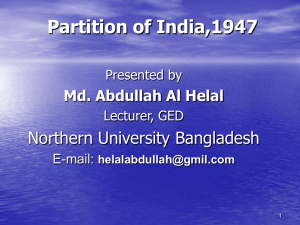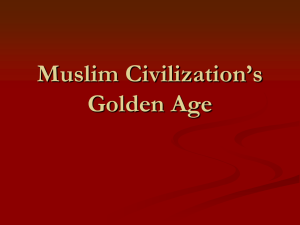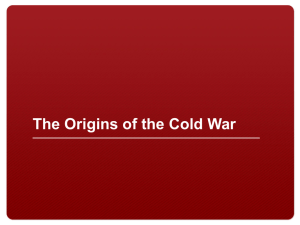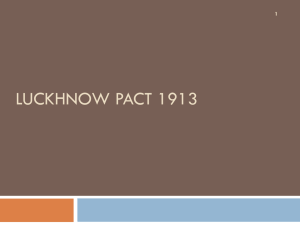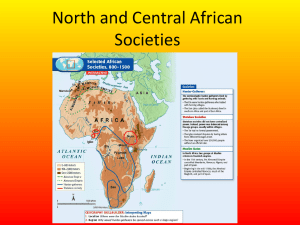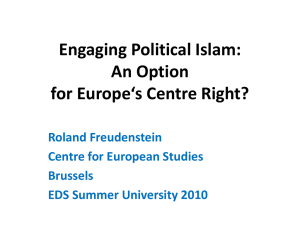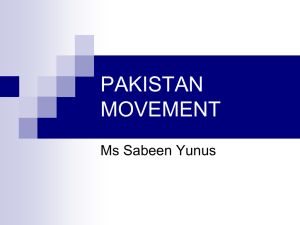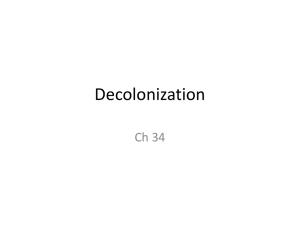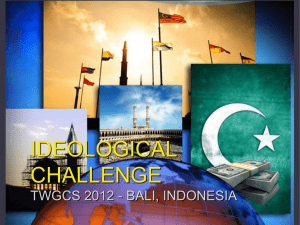Partition of India,1947
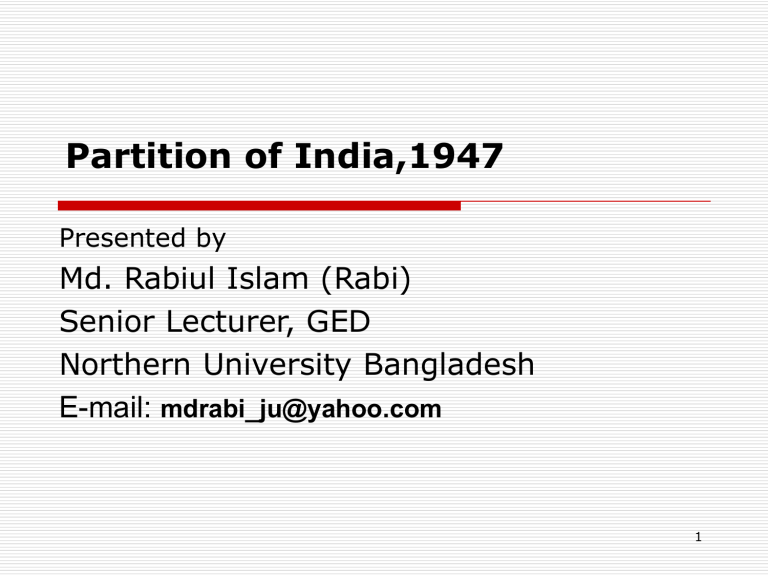
Partition of India,1947
Presented by
Md. Rabiul Islam (Rabi)
Senior Lecturer, GED
Northern University Bangladesh
E-mail: mdrabi_ju@yahoo.com
1
Map of India before the Partition of 1947
2
3
Partition of India,1947
Introduction
In1947, latest major change in the political geography of Bengal.
But all these changes and transfigurations had aroused little public curiosity until the partition of
Bengal by Curzon in 1905.
After that, participation of local people increased in the field of administration, politics and so on.
That is why gradually raised Indian nationalism by both side separately, Muslim nationalism and
Indian nationalism (led by Hindu).
4
5
6
7
Partition of India,1947
Background of Partition:
Two nation theory:
Muslim of south Asia believe that Islam and Hinduism are not only two religious but also two social orders that have given birth to two distinct cultures with no similarities.
Despite living together for more than a thousands years, they continued to develop different cultures and traditions.
8
Partition of India,1947
Background of Partition:
Two nation theory:
Their eating habits, music, architecture, and script, and even the language they speak and the dresses they wear are entirely different.
Sir Syed Ahmad Khan began the period the Muslim self awakening; Allama Iqbal proved the philosophical explanation; Jinnah translated it into a political reality.
9
Partition of India,1947
Background of Partition:
Two nation theory:
The basis of their (Muslim) nationhood is neither territorial, racial, linguistic nor ethnic, rather they are a nation because they belong to the same faith, Islam.
They demanded that areas where they were in majority should be constituted into a sovereign state.
10
Partition of India,1947
Background of Partition:
Two nation theory:
As early as in the beginning of the 11 th century Al-
Biruni observed that Hindus different form the
Muslims in all matters and habits.
Speech made by Jinnah on March 22, 1940 was very similar to AlBiruni’s thesis in theme and tone. In this speech, he stated that Hindus and Muslims belong to two different religious philosophies, with different social customs and literatures.
11
Partition of India,1947
Background of Partition:
Two nation theory:
They neither intermarry, nor eat together, and indeed belong to two different civilizations whose very foundations are based on conflicting ideas and concepts.
He emphasized that in spite of the passage of about 1000 years the relations between the
Hindus and Muslims could not attain the level of cordiality.
12
Partition of India,1947
Background of Partition:
Two nation theory:
That is why the main theme of Two Nation Theory was should be arranged separate territorial entity for the Muslim community in the sub continent.
Jinnah argued that, by the Muslim majority areas different sovereign states should be established.
13
Partition of India,1947
Lahore Resolution:
In 1940, Mohammed Ali Jinnah called a general session of the All India Muslim League in Lahore to discuss the situation that had arisen due to the outbreak of the Second World War and the
Government of India joining the war without taking the opinion of the Indian leaders.
To analyze the reasons that led to the defeat of the
Muslim League in the general election of 1937 in the Muslim majority provinces
14
Partition of India,1947
Lahore Resolution:
On March 23, 1940, a resolution was moved in the open session of the Muslim League by A.K. Fazlul
Huq.
The Lahore Resolution ran as follows:
That the areas where the Muslims are numerically in a majority as in the Northwestern and Eastern zones of India should be grouped to constitute
'independent states' in which the constituent units shall be autonomous and sovereign.
15
Partition of India,1947
Lahore Resolution:
The news of the adoption of the resolution was flashed all over the world.
Choudhury Khaliquzzaman recalls: “the next morning the Hindu press came out with big headlines
‘Pakistan Resolution Passed’, although the word was not used by any one in the speeches nor in the body of the resolution.
The Nationalist press supplied the Muslim masses a concentrated slogan which immediately conveyed to them the idea of a state.
16
Partition of India,1947
Formation of Pakistan:
Pakistan came into being as a Muslim state on 14
August 1947 consequent upon the end of the
British colonial rule.
But the Congress opposed all proposals for partition and advocated a united India with a strong centre and a fully responsible parliamentary government.
17
Partition of India,1947
Formation of Pakistan:
In August 1942, Gandhi launched quit India movement against the British.
Jinnah condemned the movement.
The govt. retaliated by arresting about 60,000 individuals and outlawing Congress.
Communal riots increased. Talks between Jinnah and Gandhi 1944 proved as futile as negotiations between Gandhi and viceroy.
18
Partition of India,1947
Formation of Pakistan:
During World War II, the Muslim League and Indian
National Congress adopted different attitude toward British rule.
Muslim League, however, followed a course of cooperation, gaining time to consolidate.
The British appreciated the loyalty and valor of the
British Indian Army in which the majority were
Punjabi Muslims.
19
Partition of India,1947
Formation of Pakistan:
Muslim League’s success could be gauged from its sweep of 90 percent of the Muslim seats in the
1946 elections, as against only 4.5 percent in the
1937 election.
Congress and the Muslim League emerged from the
1946 election as the two dominant parties.
Although the Muslim League again was unable to capture a majority of the Muslim seats in the North-
West Frontier Province.
20
Partition of India,1947
Formation of Pakistan:
When the viceroy proceeded to form a interim government without the Muslim League, Jinnah called for demonstrations or direct action day on
16 August 1946.
Communal riot broke out on an unprecedented scale, especially in Bengal and Bihar.
The massacre of Muslim in Calcutta brought Gandhi’s to the scene, where he worked with the Muslim
League chief minister, Huseyn Shaheed
Suhrawardi.
21
Partition of India,1947
Formation of Pakistan:
In July 1947, the Indian independent act was passed to set up the Dominions of India and Pakistan.
On August 14, 1947, within eight years of the adoption of the Lahore Resolution, Pakistan emerged as an Independent sovereign state
And the next day India achieved Independence.
22
23
